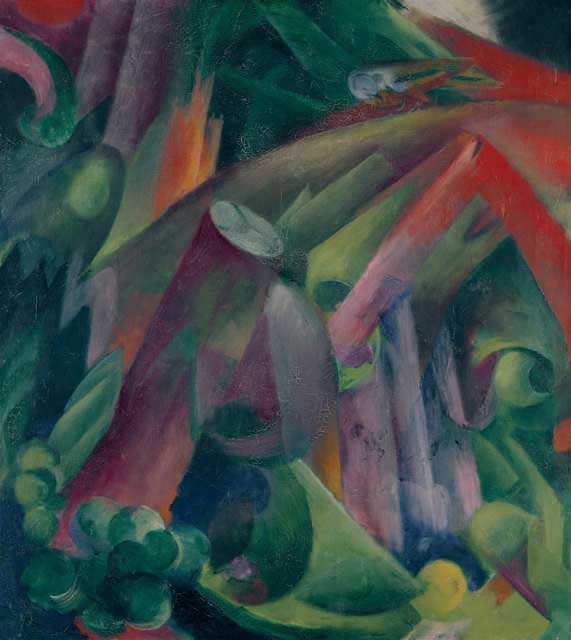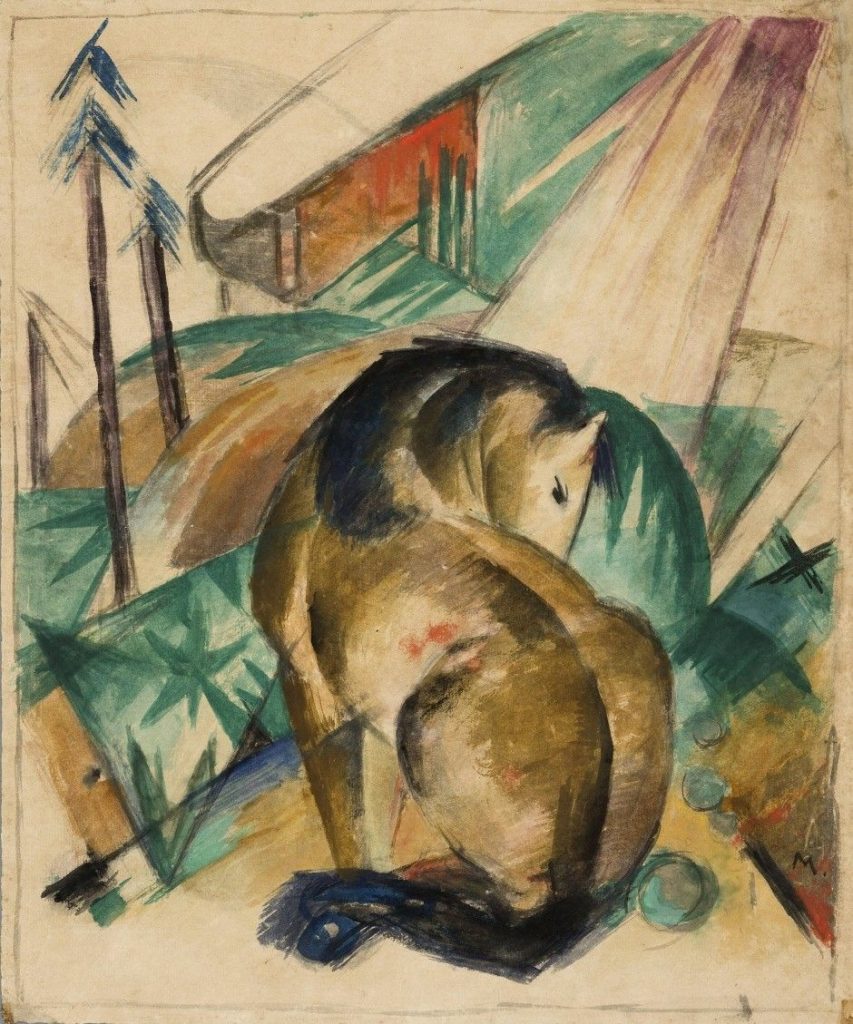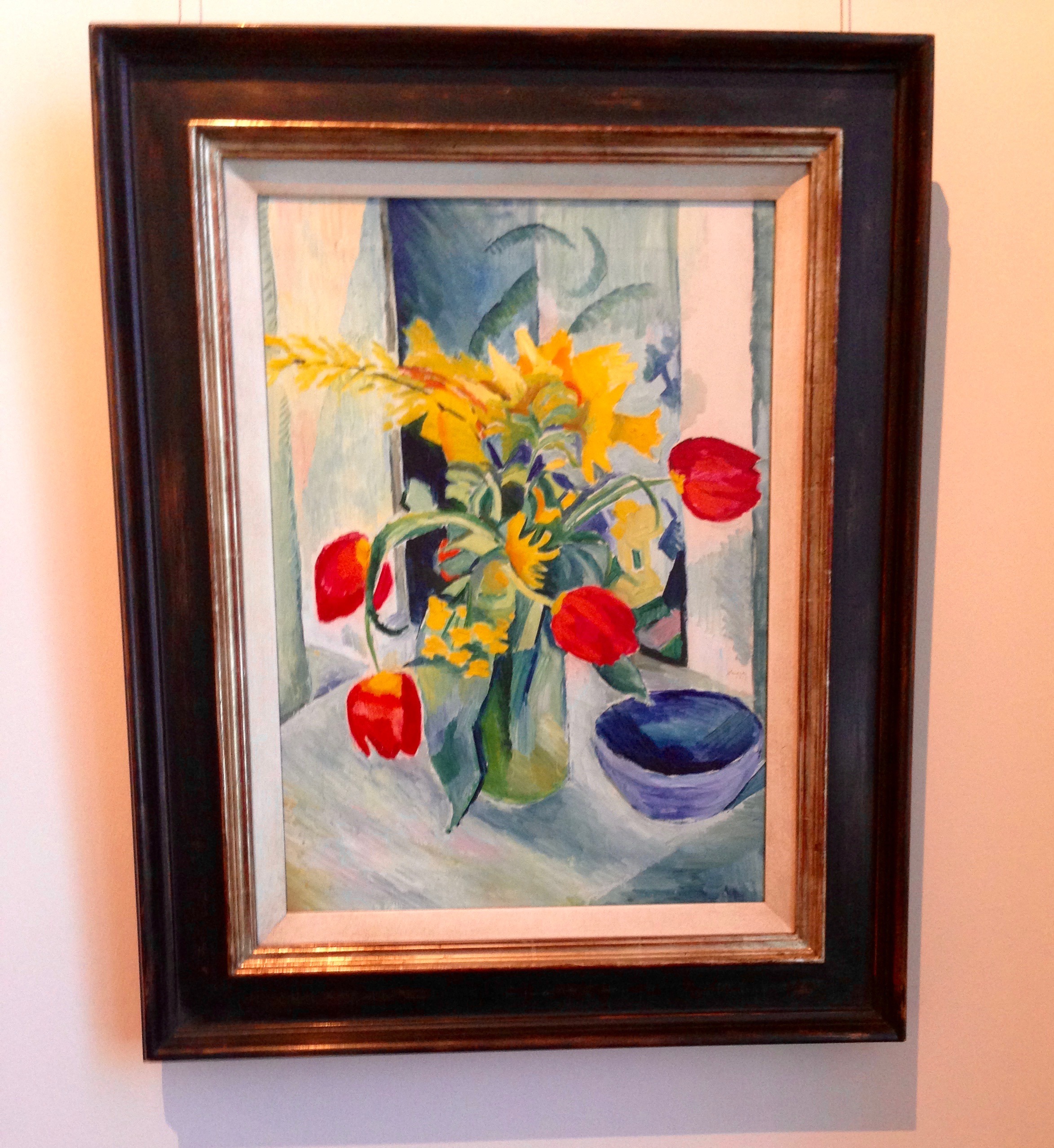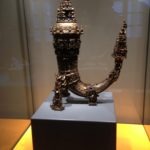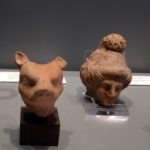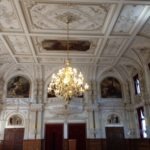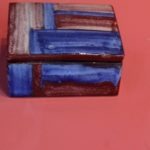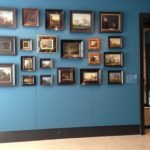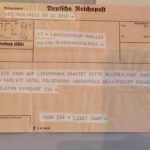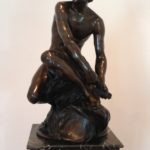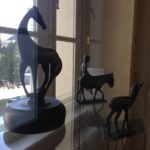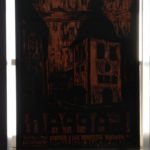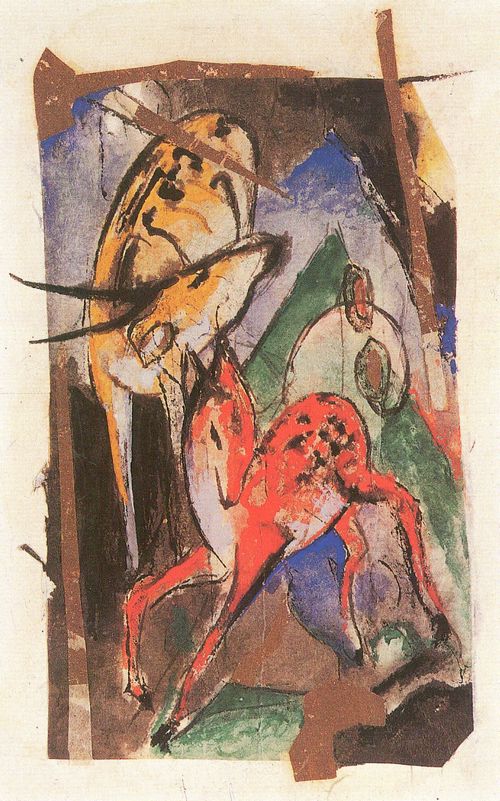Every so often, a fragrance saunters into the market, demanding our attention with an air of undeserved audacity. Jean Paul Gaultier's Divine (2023), however, feels less like a sophisticated, daring entry and more like a grandiloquent crash. Its limited notes of...
…With Parallel Commentary on the Case of Turm der blauen Pferde
…With Parallel Commentary on the Case of Turm der blauen Pferde
…Supplement to „Raubkunst at the Ringling”
In this sidebar to “Raubkunst at the Ringling,” which has appeared in this week’s in Lapsus Lima, I compare the fate of Geburt der Pferde and Schöpfungsgeschichte II, whose whereabouts are known, with the case of Marc’s famous 1913 painting Turm der blauen Pferde, which remains missing. Despite the circus that has sprung up around its memory, Turm der blauen Pferde, as a physical object, is absent. While these case studies are of interest in and of themselves, I hope also to raise questions about the ethical conduct on the parts of some museums, which, as public institutions, have an obligation – perhaps now more than ever – to stimulate, educate, and provide access and information to the patrons they ostensibly serve.
Turm der blauen Pferde has also given me, in a roundabout way, inspiration for my next line of inquiry, which takes me at last back to animal studies. I am very grateful for the support of Mónica Belevan of Lapsus Lima publishing imprint and HAUT Architectural Solutions for keeping me focused on this project and to many others who know who they are. This project began in the summer of 2016 and got a push from the Raubkunst al Erinnerungsort workshop that winter sponsored by the Zentrum für Historische Forschung Berlin der Polnischen Akademie der Wissenschaften; the Zentrum’s own scholars were then immediatley relieved of their positions for not preemptively falling in line with Poland’s implementation of the law forbidding citizens to accuse the Poles of Holocaust-related crimes. And things are worse now.
In the summer of 2017, a jointly-sponsored exhibition titled Vermisst: Der Turm der blauen Pferde von Franz Marc: Zeitgenössische Künstler auf der Suche nach einem verschollenen Meisterwerk (Missing: The Tower of Blue Horses: Contemporary Artists in Search of a Lost Masterpiece) opened at both the Pinakothek der Moderne in Munich and the Haus am Waldsee in Berlin. The parallel shows feature works themed around Franz Marc’s 1913 totem of Modernism. Naturally as a Marc researcher nothing delighted me more than seeing artists of our own time so moved to create by Marc’s work.
But it also seems to me that by making a crime committed by the Nazis into a social media event – the Pinakothek exhorted visitors to the exhibit to “keep the mystery of this icon of painting alive”[i]– German museum culture once again obfuscated reality. In fact the only “mystery” is that the whereabouts of the famous stolen painting are unknown, and the museums who profit from celebrating the work of the Blaue Reiter have done very little to abet Turm der blauen Pferde’s recovery. Perhaps because of this intent to diffuse, the thematic homages to monumental painting were ranged from tepid to terrible (the notable exception being Marcel van Eeden’s High Mountains, a Rainbow, the Moon and Stars).
In fact over the years, many opportunities to learn more about the Turm’s fate have gone unmet. In early 2001, Jan A. Ahlers, the Herford textile magnate and well-known collector of Expressionist art, received an intriguing offer. An anonymous “seller,” his or her identity nonetheless verified by an intermediary at a bank in Zurich, wanted Ahlers to quietly purchase and repatriate Marc’s Turm der blauen Pferde. The canvas, according to this account, had been hidden by then for more than 50 years in a bank vault in Switzerland.
Instead of accepting a meeting, Ahlers approached the then recently-opened Franz Marc Museum in Kochel and the Westfalian state authorities. To Ahlers’s surprise, nothing happened, and, frustrated, he ended up telling his story to the Berliner Zeitung and Artmagazine.[ii]Ahlers died in 2013, having never been interviewed by German federal or state investigators. The seller or sellers, and with them the painting, disappeared once more.
Yet the earth continues to give up its Nazi secrets, sometimes literally, as in 2010 when excavators in Berlin surveying property around the new Reichstag found Emy Roeder’s 1919 die Schwangere, missing since 1937, dangling from the prongs of a backhoe. It was both thrilling and horrifying to learn in November 2013 that Marc’s missing 1911 canvas Pferde in Landschaft had also been hiding since the 1940s, this time quietly in the Schwabing apartment of Cornelius Gurlitt. Saddening was the fact that many, many people – amid them museum staffers, Bavarian state police, and German federal agents – had been aware of what became known as the “Gurlitt Hoard” for years, and cooperated with the police in not revealing its somewhat accidental seizure – the elderly son of another art-dealer-to-the-Nazis, Hildebrand Gurlitt, was actually nabbed for behaving suspiciously on a train from Zürich to Munich, and was found to be carrying more thn €100,000 in his pockets.[iii] Naturally the curators of the Städtische Galerie im Lenbachhaus und Kunstbau München – the repository of the world’s largest collection of the art of the Blaue Reiter – were called upon to authenticate the Marc painting as well as works by Wassily Kandinsky and August Macke. Annegret Hoberg, for more than 25 years the Blaue Reitercurator at the Lenbachhaus and the acknowledged expert on Marc’s professional career, had been in on this omission of silence. Hoberg has devoted her life’s work to the Blaue Reiter. Yet she did not love it enough to shout joyfully from the rooftops of the Gurlitt discovery, or think enough of the citizens of Munich (whom I assure you are as enthusiastic fans of the single native Bavarian Blue Rider as they are the Bayern München football club) whose taxes and donations pay for the city gallery to break the silence.
I believe Turm der blauen Pferde probably exists somewhere in the world – though since I began this quest I have changed my position on what a hopeful outcome to its loss would entail. But questions related to provenance research seem to begin, not end, with the discovery of missing and stolen artwork from the entartete Kunst catalogue. The story about Turm der blauen Pferde, which, while likely true has now grown so distant as to become apocryphal, made me curious about the psychological resistance, particularly in museum and legal cultures both in Germany and the United States, to dealing directly even with confirmed cases of located “missing” artwork, such as in the case outlined in my story Raubkunst at the Ringling. Marc’s missing painting is paradoxically one of the most recognizable art objects in the world, reproduced after World War II ad infinitum on postcards, postage stamps, T-shirts, coffee mugs, and keychains. Marc was an emblem for Germany’s reclamation of the historical avant-garde, and, yet, as a daring and heroic cavalry officer awarded the Iron Cross before being killed at Verdun in 1916, he was indisputably a patriot. Reified through replication, the shock of Marc’s crystalline colors and embodied animals was displaced and diminished. Turm der blauen Pferdeis a cipher, an eternally reproduced copy without an original.
Turm der Blauen Pferde is two images, one the 2 by 1.3 metres painting missing since 1949, when it was last seen in Berlin’s Haus am Waldsee, the other 14 by 9 centimetres postcard in the Bayerische Staatsgemäldesammlungen in Munich.The images are not identical but they do show the same group of four horses, and we can reconstruct their identities from knowing more about what Marc had been reading and looking at before he made these two paintings.
In his biography of Marc, Klaus Lankheit gives an elegant account of the large painting:
The artist’s most famous [work] captures us in its spell. (…) We are drawn to the image even as we are forced to keep at a respectful distance. The group of four horses glows like a vision in front of us. Moved just to the right of the central axis, the outline of the narrow portrait fills the canvas almost entirely revealing to the side just a glimpse of an equally mysterious landscape.
The powerful body of the animal in front measures only slightly under life size. The horse appears to push forward from the depths and to [animate] immediately in front of the viewer by throwing his head to the side. His position in space cannot be calculated, because the bottom of the frame overlaps the two legs.[iv]
This is valuable information, because Lankheit had the opportunity to closely study the painting that has been seen by very few people living today. Lankheit’s passage eschews a lengthier description of the celestial markings adorning the animals, which are one of the chief differences between the postcard and the painting. Lankheit observes also how the “clear-cut crescent of the moon” is in contrast on the chest of the darkest of the four horses, acknowledging the individuation of the animals.[v ]There is a solar aspect to both the painting and the postcard, and we can infer that Marc is making both a reference to and a statement about animals representing the Helios horses for the new age. In Marc’s vision the horses are unrestrained by a charioteer. They are ennobled not by the gods and goddesses but by their union with the Earth and the constellations.
The horses in the painting inhabit a more vibrantly colored landscape (owing possibly to the deterioration of the postcard, or the enhancements to the digital images and photographs we have of the painting we have at hand to consider), have less distinct outlines, and fewer astronomical markings. Nevertheless, the open-topped, heraldic crescent has been retained on the chest of the front horse.
The postcard to Else Lasker-Schüler, Turm der blauen Pferde is inscribed with the title of the work. In the horses’ other lives in the monumental painting, they inherited and kept that name and traveled to Berlin for the 1913 Erster deutscher Herbstsalon. Of the sometimes seemingly playful greetings to Prince Jussuf, the postcard is unusually somber, and Lasker-Schüler seems to recognize the peculiarity of the luminous hierarchy of four when she speaks of them as “whinnying archangels.”[vi]
My point in relating these details is that as a real object with an actual history of its own, and a post-life as Raubkunst, is that Turm der blauen Pferde deserves, on the one hand, as a painting, to be the subject of continued study and interpretation. As art historians we know that this practice is really what keeps a work of art alive in the minds and eyes of spectators. As a victim itself of looting, the painting’s fate deserves to be known. The German museums devoting so many resources to celebrating its disappearance would do well to take a hard look at the circumstances of its vanishing, and uncovering its likely whereabouts.
And yet. And yet. Marc himself had told Annette von Eckardt in 1914 in a response to a telegram she had sent that summer from Sarajevo describing the cataclysm set in motion that he wasn’t worried about the afterlives of his work. My new research project has taken me to Norway, to the Iron Age carvings of horses and runes on stone totems, and farther away and back, to the Aurignacian peoples who decorated the Chauvet Cave with their own towers of horses. Visiting an archaeological site in Rogaland in fall 2018, I stood with Elna Siv Kristoffersen of the Arkeologisk Museum i Stavanger looking at a small depression near the North Sea that had recently yielded a 900-year-old Viking ship. I asked how the Kristoffsersen, who studies the animal totems associated with Fifth Century Norse funerary practices, how she went about deciding where to excavate. “Oh, we don’t,” she exclaimed. “These are sacred places. They reveal themselves when they are ready. We don’t disturb the dead.” Seeing me simultaneously nodding, smiling, and, suddenly, tearful, Kristoffersen added softly. “We’ll never know what really happened in the past – not really. It is hubris to think this is possible. Some things must remain mysteries.”
After a moment she asked, “What about your painting?” I had showed Turm der blauen Pferde and told its story at a conference devoted to horses at the museum. I realized at that moment something that the new project would turn on; that I had felt, deep down, all along, a feeling confirmed by the circus at the Haus am Waldsee and Pinakotheken. “It’s gone,” I said turning to to Kristoffersen. “I hope they never find it.”
[i]“Missing: Franz Marc’s The Tower of Blue Horses,” last modified 3 March 2017, https://www.pinakothek.de/en/exhibitions/missing-franz-marc-s-tower-of-blue-horses-contemporary-artists-search-of-a-lost
[ii]Joachim Nawrocki, “Ersitzen oder Besitzen?” Die Welt, 25 May 2001.
[iii]For a complete account of the Gurlitt case, see Catherine Hickley. The Munich Art Hoard: Hitler’s Dealer and His Secret Legacy. (London: Thames & Hudson Ltd., 2016) On the role of the media in reporting on restitution and Nazi looted art: Alexandra Herfroy-Mischler. “When the ast seeps into the present: The role of press agencies in circulating new historical narratives and restructuring collective memory during and after the Holocaust transitional justice.” Journalism. Vol 17, Issue 7 (13 July 2015), pp. 823-844
[iv]Das berühmteste Bild des Künstlers (…) schlägt uns in ihren Bann. Wir werden mit Macht an das Bild herangetrieben, schon im selben Augenblick aber zu achtungsvoller Distanz gezwungen. Wie eine Vision leuchtet dicht vor uns eine Gruppe von vier Pferden auf. Aus der Mittelachse nach rechts gerückt, füllt ihr Umriß das schmale Hochformat fast ganz aus, nur seitlich den Blick auf eine ebenso geheimnisvolle Landschaft freigebend. Der mächtige Körper des vorderen Tieres mißt nur wenig unter Lebensgröße. Das Pferd scheint aus der Tiefe nach vorn zu drängen und unmittelbar vor dem Beschauer zu verhalten, indem es den Kopf in edlem Schwung zur Seite wirft. Seine Stellung im Raum läßt sich nicht errechnen, denn der untere Bildrand überschneidet die Beine (…).” Klaus Lankheit. Franz Marc: Sein Leben und seine Kunst. (Köln: Dumont), 120. My translation.
[v]In a volume Marc had in his own library – he discusses it as early as 1899 – Plato tells us that the four Helios horses had distinct attributes and personalities. The first (the horse in the front of the painting) is characterized by immense beauty, size, and speed. Though Marc shows the sun and moon glowing within this animal, he also has an individuated, recognizable blaze painted on the team leader’s face. The second horse, named after Hera, steers the chariot; the third “dark horse” upon whom the sun nonetheless shines is called Poseidon (slower than the second); and the fourth, stiffly relegated to the back, takes her name from Hestia: “The horses are peaceful and friendly and one does nothing without the others.” Plato and John Alexander Stewart, The Myths of Plato Translated with Introductory and Other Observations, (London: Macmillan, 1905), 173.
[vi]“Deine glückseligen, blauen Pferde sind lauter wiehernde Erzengel und galoppieren alle ins Paradies hinein.” Franz Marc and Else Lasker-Schüler, Der Blaue Reiter präsentiert Eurer Hoheit sein Blaues Pferd: Karten und Briefe, (Prestel: München, 1988), 144. My translation. See also: Betty Falkenberg, Else Lasker-Schüler: A Life, (McFarland: Jefferson, N.C.: 2003), 86.
RECENTLY ON MICHELANGELOST™...
Gaultier’s Dubious Divinity: A Troma Tragedy
Norwegen Blumen / Norway Flowers I
Norway Flowers / Norwegen-Blumen I
Eden and Everything After
From: 21 January 2023-21 December 2023 Opening: 21 January 2023, 14:00 University of Stavanger Archaeological Museum Peder Klows gate 30A 4010 Stavanger Norway Hours: Tuesday 11 – 20 Wednesday – Sunday 11 – 16 Monday closed....


